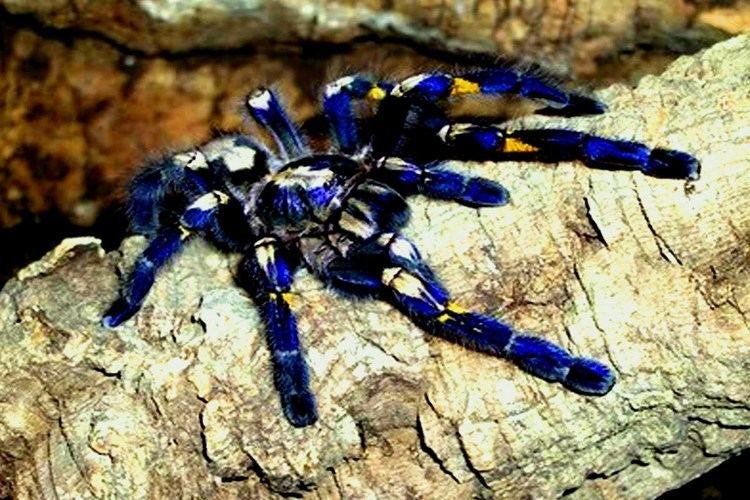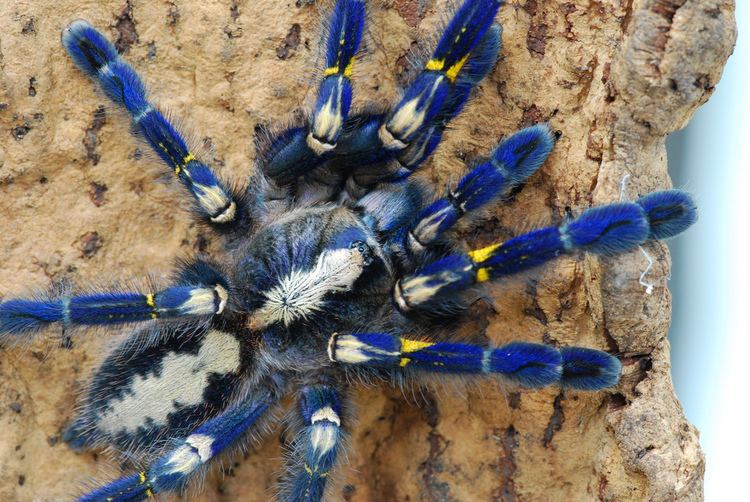Similar | ||
Gooty sapphire ornamental poecilotheria metallica feeding
Poecilotheria metallica is a species of tarantula. It reflects brilliant metallic blue colour. Like others in its genus it exhibits an intricate fractal-like pattern on the abdomen. The species' natural habitat is deciduous forest in Andhra Pradesh, in central southern India
Contents
- Gooty sapphire ornamental poecilotheria metallica feeding
- Poecilotheria metallica gooty sapphire ornamental
- Distribution
- Behaviour
- Venom
- Coloration
- Common names
- Conservation
- References
Poecilotheria metallica gooty sapphire ornamental
Distribution

P. metallica is found only in a small area of less than 100 square kilometres (39 sq mi), a reserve forest that is nonetheless highly disturbed. Surveys of adjacent forest have failed to observe this species. The type specimen was discovered in a railway timber yard in Gooty about 100 km southwest of its known range, but it is believed to have been transported there by train.
Behaviour

P. metallica's behaviour parallels that of many arboreal spiders. In the wild, P. metallica live in holes of tall trees where they make asymmetric funnel webs. Their primary prey consists of various insects. It has been observed that the spiders of this genus may live communally when territory, i.e. number of holes per tree, is limited.

This species is desired by many tarantula enthusiasts, with adults sometimes pricing above $500 in the United States. Demand for 2-week-old unsexed spiderlings at US$200 is high, and there are examples of their being sold for much more. Prices can vary in other locations, particularly Europe. Like many spiders, the sex can influence price; females live for about 12 years, 3 to 4 times longer than males, making them more expensive. Also females are considered to be more useful for breeding, making demand higher. They are hardy, relatively fast-growing spiders that are generally fed crickets, but can take on anything from a common fruit fly when spiderlings, to a new-born (pinky) mouse or anole when adults. They measure between 15 to 20 cm (6 to 8 in) in legspan when fully grown. In captivity, humid environments with temperatures between 18 to 24 °C (64 to 75 °F) and a humidity level of 75 to 85% are preferred.
Venom

There has never been a recorded human death from its bite; however, this species is considered to have a medically significant bite, with venom that may cause intense pain, judging from the experience of keepers bitten by other spiders from this genus. A quick search of bites from this species shows the vast majority are so called "dry bites" where no venom is injected into the handler. The mechanical effects of the bite can still be worrisome, as an adults fangs can reach nearly 3/4 of an inch in length. They can move rapidly and may defend themselves when cornered, although they are more likely to attempt to scurry away than fight. Venom effects consist of a small heart rate increase followed by sweating, headache, stinging, cramping and swelling. Effects can last for up to a week.
Coloration
The vivid colours of the spider are produced by nanostructures. Structural colours are usually are highly iridescent, changing colour when viewed from different angles (an effect seen in peacocks and butterflies). Some species of blue tarantulas have hairs with a "special flower-like" structure which have been hypothesized to reduce iridescence, an effect that is being used to in the development of novel materials.
Common names
P. metallica was first discovered in the town of Gooty, a fact reflected in some of its common names: Gooty sapphire ornamental tree spider, Gooty sapphire, and Gooty tarantula. Other common names are metallic tarantula, peacock parachute spider, peacock tarantula, or salepurgu.
Conservation
P. metallica is classified as Critically endangered by the IUCN due to its occurrence in a single small area where its habitat is rapidly degrading. The primary threats to the species' survival are habitat degradation and loss to logging and firewood harvesting. Another threat identified by IUCN assessors is specimen collection for the pet trade. Population size is unknown, but the combination of its small natural range and the threats in that area indicates a declining population trend.
